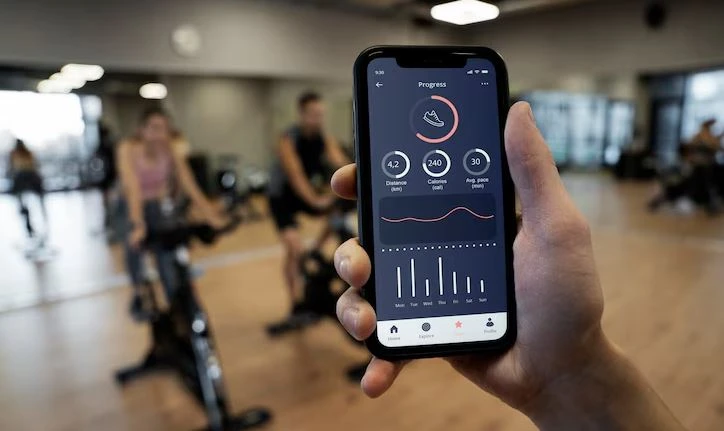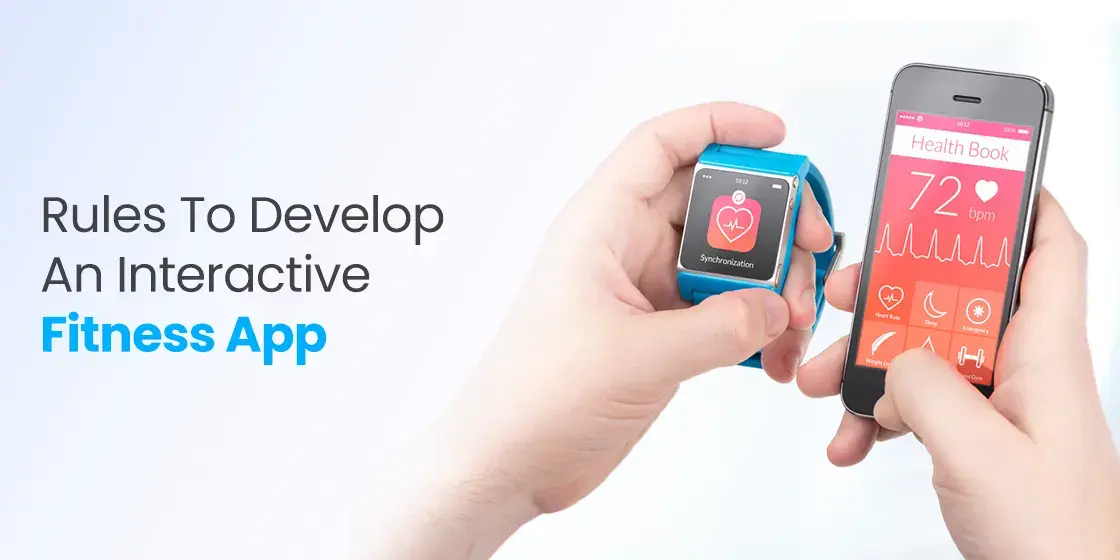Table of Content
Know the Complete Process to Develop a Quality Fitness Application
The popularity of fitness apps is rapidly increasing, because more and more people are acknowledging the importance of a healthy lifestyle. They have understood the fact that regular exercises and yoga sessions are extremely important to keep their fitness on track. However, many of them are unable to go to gyms or fitness centers due to tough work schedules. That is where specialized fitness apps are helping them to overcome this gap. These apps provide them a complete fitness plan comprising of various modules. The demand of fitness app development is therefore increasing, as people are using them to know about different types of exercises online.
During the last few years, it has been noted that people are more actively using fitness apps. This has encouraged many companies to launch their own fitness apps to facilitate these people. They actively look to develop these apps by a professional software development company having years of expertise in the dev industry. This model is actually followed by those who have got no knowledge about technicals, hence they look towards specialized vendors like StruqtIO to develop quality cross platform fitness applications.
However, those who are looking to develop these apps by themselves, can follow a dedicated fitness app development plan. In this blog, we will discuss about this plan in detail, so that you can understand how to get started with it. Let’s first start from the basics understanding what is a fitness app and why it is becoming popular among the fitness enthusiasts.
What is a Fitness App?

A fitness app is a specialized mobile application designed to assist users in tracking and improving their physical health and wellness. These apps typically offer a range of features tailored to different aspects of fitness, including exercise tracking, diet monitoring, goal setting, and progress analysis. Users can access these apps on various devices such as smartphones, tablets, and wearable fitness trackers, making them highly accessible and convenient for individuals looking to maintain or improve their fitness levels.
One of the key functionalities of a fitness app is exercise tracking. Users can record their workouts, whether it’s cardio, strength training, yoga, or any other form of physical activity, allowing them to monitor their progress over time. These apps often provide guidance on proper form and technique, offer workout routines tailored to specific fitness goals, and track metrics like distance, duration, and calories burned. By keeping a record of their workouts, users can stay motivated and accountable while working towards their fitness objectives.
In addition to exercise tracking, many fitness apps also include features related to nutrition and diet management. Users can log their meals and snacks, track their calorie intake, and set dietary goals based on their individual needs and preferences. Some apps offer meal planning tools, recipes, and nutritional information to help users make healthier choices and maintain a balanced diet. By combining exercise tracking with diet monitoring, fitness apps provide a comprehensive approach to health and wellness, empowering users to make positive lifestyle changes and achieve their fitness goals.
Statistical Facts About Fitness Apps

The burgeoning global health and fitness app development market is experiencing exponential growth, particularly in countries such as the United States, where app downloads and user engagement are at the forefront of this trend. According to Statista, projections indicate a remarkable trajectory for the fitness app market, forecasting a revenue surge to $6.86 billion by the end of 2024, followed by a substantial market value ascent to $10.04 billion by 2028. This anticipated growth signifies a remarkable compound annual growth rate of 9.99% from 2024 to 2028, underlining the sustained momentum and significant opportunities within this sector.
The surge in the health and fitness app development market is fueled by several factors. Firstly, the proliferation of smartphones and wearable fitness devices has made accessing and utilizing fitness apps increasingly convenient for users of all demographics. Additionally, the growing awareness and emphasis on health and wellness globally have prompted individuals to seek accessible tools to monitor and enhance their physical fitness. Furthermore, technological advancements have enriched the functionalities of fitness apps, offering users tailored workout routines and personalized nutrition plans.
Moreover, the COVID-19 pandemic has served as a significant catalyst for the adoption of health and fitness apps. Seeing the past restrictions on gym access and outdoor activities, individuals turned to digital solutions to maintain their fitness routines and overall well-being. This shift in consumer behavior has accelerated the demand for fitness apps, prompting developers to innovate and expand their offerings to meet the evolving needs of users. As such, the projected growth trajectory of the fitness apps underscores its resilience and adaptability in catering to the dynamic landscape of health and wellness.
Popular Types of Fitness Apps

There are different types of fitness apps currently available in the market. They offer guidance related to different types of fitness exercises. If you do not know much about them, take a look at their categories given below. This will help you to decide which app should be followed based on your required fitness preferences and plans.
Workout Fitness Apps
Workout fitness apps are specifically designed to assist individuals in planning, tracking, and optimizing their exercise routines. These apps offer a wide range of features tailored to various fitness goals, preferences, and skill levels. Users can access a plethora of workout routines, including cardio, strength. yoga and more through these apps. Many workout fitness apps provide guided workout sessions led by certified fitness instructors or virtual coaches to train individuals in a proper manner.
Activity Tracking Apps
Activity tracking apps are digital tools designed to monitor and analyze various aspects of an individual’s physical activity throughout the day. These apps typically utilize sensors embedded in smartphones or wearable devices such as fitness trackers or smartwatches to gather data on movement. By leveraging this data, activity tracking apps provide users with valuable insights into their daily activity levels, helping them make informed decisions to improve their overall health and fitness.
Diet & Nutrition Apps
Diet and nutrition fitness apps are designed to help individuals manage their dietary intake and make healthier nutritional choices. These apps offer a wide range of features aimed at tracking food consumption, monitoring calorie intake, analyzing nutritional content, and facilitating meal planning. Users can log their meals and snacks, either manually or by scanning barcodes or selecting items from a comprehensive food database, allowing them to keep a detailed record of their dietary habits.
Fitness App Development: Easy Step-by-Step Process

Developing a fitness app is not that difficult if you’ve got a prior knowledge of cross platform app development. Unfortunately, many people do not know about these details, which is why they face difficulty while creating the app.
If you are also facing such problems, take a look at the points defined below. It will give you a brief idea how fitness app should be developed right from the scratch to finish.
Build a Development Plan
The initial phase of embarking on custom fitness app development entails a meticulous process of conceptualization. Central to this stage is the strategic decision-making regarding the app’s focus, whether it will cater to particular fitness activities such as workouts, running, or yoga, or offer a versatile platform encompassing a myriad of functionalities. Comprehensive market research becomes imperative during this juncture, involving an in-depth analysis of latest tech trends in UAE, identification of potential market lacunae, and the discernment of the appropriate category of app to be developed.
Subsequent to the conceptualization phase, the development trajectory delves deeper into the intricacies of materializing the envisioned fitness application. This entails a systematic outlining of app’s architecture, wireframing its user interface, and drafting detailed technical specifications. Collaborative brainstorming sessions are often convened to crystallize the conceptual framework into a tangible blueprint, ensuring alignment with the app’s overarching goals and user expectations.
Select the Type of Fitness App
Following the initial phase of conceptualization, the subsequent step entails a nuanced decision-making process regarding the specific genre of fitness application tailored for the intended audience. It necessitates a comprehensive understanding of the target demographics’ diverse fitness objectives, preferences, and challenges to discern the optimal type of fitness app that aligns with their requirements. Delving into the intricacies of market segmentation, this phase involves a meticulous analysis of users’ fitness goals, lifestyle choices, and pain points.
Furthermore, the decision-making process extends beyond mere categorization to encompass a detailed evaluation of each potential genre’s viability and relevance within the prevailing market landscape. This entails a discerning assessment of the custom software development trends in UAE, competitor analysis, and user feedback to ascertain the optimal alignment between the chosen app category and the target audience’s evolving needs and preferences. Moreover, considerations extend to the integration of supplementary features and functionalities that complement the core app offering.
Select Tools and Technologies
Selecting the appropriate development stack for a fitness app is a critical decision that impacts its overall success. Firstly, it’s imperative to assess the specific requirements and objectives of the fitness app. Factors such as the complexity of features, expected user base, and desired platform compatibility play a crucial role in determining the development stack. If real-time tracking is essential in the app, then choosing a stack that supports seamless data synchronization and processing in real-time becomes paramount.
Secondly, evaluating the proficiency and expertise of the development team in various technologies within the stack is vital. It’s essential to leverage the strengths of the team and select technologies that align with their skill sets to expedite development and minimize learning curves. Additionally, assessing the availability of robust third-party libraries, APIs, and mobile development tools within the chosen stack can streamline development efforts and enhance overall efficiency.
Start Fitness App Development
Entering the pivotal phase of app development, the dedicated team transitions from conceptualization to actualization, transforming your fitness app concept into a tangible reality. This multifaceted stage encompasses the meticulous construction of both the app’s backend infrastructure and frontend interface. Tailoring the development process to the chosen platform—be it iOS, Android, or a cross-platform solution—developers adeptly employ appropriate programming languages to ensure optimal performance and compatibility.
Just like FemTech app development, every aspect of the fitness app’s functionality is meticulously crafted to cater to the diverse needs of users striving for a healthier lifestyle. From the creation of intuitive user profiles to the implementation of robust activity tracking mechanisms and personalized workout plans, developers diligently incorporate essential features aimed at fostering engagement and achieving fitness goals. Moreover, strategic integration of monetization models further enrich the user experience, empowering individuals to adopt and sustain healthier habits.
Test the Application
Pre-deployment testing and quality assurance stand as pivotal stages in the development lifecycle before launching your product onto the targeted platform. These phases are instrumental in meticulously identifying and rectifying any potential bugs, glitches, or errors that could compromise the functionality and user experience of the application. Comprehensive testing procedures encompass a blend of manual testing processes executed by skilled QA engineers to find hidden bugs and errors.
Manual testing involves hands-on exploration of the application’s features and functionalities to pinpoint any inconsistencies or deficiencies in user experience. Concurrently, automated testing methodologies leveraging cutting-edge testing frameworks are employed to conduct rigorous assessments of the app’s performance under diverse conditions. By conducting both of them properly, you ensure to roll out the fitness app with zero errors.
Important Features to Include in a Fitness App

The success of any mobile application depends a lot on its features. This case also applies in the fitness app development, as people will only use those apps that are built with interactive features. If you do not know which type of features should be present in a fitness app, take a look at the list given below.
Activity Tracking
Developing a fitness wearable app necessitates the incorporation of robust activity tracking functionality. This feature must seamlessly align with a multitude of other app features, enabling the comprehensive monitoring of key user metrics like heart points, step count, distance covered, calories expended, and active minutes. The provision of precise and real-time tracking empowers users to diligently monitor their fitness journey and maintain optimal health and wellness.
Workout Guides
Providing users with both a pre-established collection of exercises and the freedom to tailor their own workout routines stands out as a cornerstone feature of fitness application. This functionality should accommodate a diverse range of fitness levels, personal preferences, and individual objectives, ensuring inclusivity and adaptability to varying user needs. Furthermore, the integration of diverse media formats, including 3D animated models and images serves as a perfect guide for budding trainers.
Connectivity with Wearables
Functionality that facilitates effortless integration with widely-used wearables such as fitness trackers and smartwatches significantly enhances the capabilities of applications. Moreover, ensuring compatibility with a variety of third-party applications and services enables users to consolidate their health data, fostering a comprehensive approach to wellness and empowering informed decisions based on data analysis.
Progress Tracker
It’s crucial for health and fitness apps to empower users to monitor their progress and visualize their accomplishments across time to sustain motivation and accountability. These apps should provide comprehensive analytics and progress summaries, presenting metrics such as changes in weight, body measurements, fitness milestones achieved and more others. It adds great motivation in the daily workouts, encouraging people to do their sessions more energetically.
Develop Interactive Cross Platform Fitness Apps with StruqtIO
StruqtIO possesses extensive proficiency in crafting various kinds of fitness applications. Our expertise extends to the development of state-of-the-art fitness apps, seamlessly integrated with the latest functionalities. Our dedicated teams are committed to constructing mobile applications in accordance with the prevailing industry benchmarks, ensuring users experience optimal performance all the time.
In addition to mobile app development, StruqtIO offers a wide array of tailored software solutions to meet specific client requirements. Whether it’s .NET development or seamless cloud integration, our team excels in diverse areas where businesses seek expert guidance from a reputable agency.
Frequently Asked Questions
| Why fitness apps are getting popular? Fitness apps are gaining popularity due to their convenience, providing users with personalized workout plans, tracking features, and other health insights. By using the app, these features can be accessed anywhere, fostering motivation and accountability in achieving fitness goals. |
| What is the benefit of using a fitness app? Using a fitness app offers personalized guidance and tracking, enhancing accountability and motivation, ultimately aiding users in achieving their health and wellness goals efficiently. |
| How many types of fitness apps available in the market? There are different types of fitness apps available in the market. It includes activity tracking apps, workout & yoga apps, diet management apps and more others. |
Final Words
That sums up our entire blog in which we have discussed how to develop a fitness app from start to finish. These apps are getting popular day by day, as people from diverse backgrounds are using them to stay updated with the latest techniques of body workouts. This blog has covered fitness app development in detail, so that everyone can understand the overall process of developing these apps professionally.
Meanwhile, if you are looking for a company that could help you to develop cross platform fitness applications, get in touch with us today. We have got the expertise to cater all your requirements and build quality apps using latest tools and technologies.

Empower your digital journey with StruqtIO - Your dedicated partner for cutting-edge custom software development, innovation, and digital transformative solutions. Harness the power of technology to elevate your business and redefine your digital landscape today.


